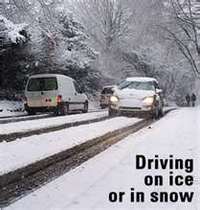Cooper Tire Recommends Preparing for Winter Driving Before the First Storm
 |
FINDLAY, OH--Oct. 8, 2012: Conditions like snow-covered roads and black ice often make winter driving unpredictable. To help prepare and keep motorists safe on winter roads, Cooper Tire & Rubber Companyencourages drivers to not only install winter tires before the first storm hits, but also use the changing seasons as a reminder to engage in routine tire maintenance. Preparing early for winter weather and anticipating and avoiding dangerous circumstances can help drivers maintain control and stay safe on the road.
"Drivers should consider replacing their all-season tires with a product made specifically for winter road conditions," said Chuck Yurkovich, vice president of global technology for Cooper Tire. "The key is to have those discussions with a trusted dealer before the first storm hits. Even if an area does not typically receive harsh winter weather, it's important to conduct routine tire maintenance checks as the seasons change."
Cooper Tire has been a proven winter tire brand for decades providing high-performing and extensive product lines that cover more than 90 percent of vehicles, such as the Weather-Master S/T2 , the Weather-Master WSC and the Discoverer M+S. All Cooper winter tires include a patented snow groove technology that retains snow in the tread grooves, capitalizing on the higher traction of "snow on snow" versus "snow on rubber." The compound is formulated to respond with higher levels of grip in ice, slush and other winter conditions.
In addition to properly equipping vehicles with winter tires, Cooper Tire advises drivers to follow basic winter driving and tire maintenance tips:
Drive cautiously: Experts say the best advice for driving in harsh winter weather is to not drive at all, but according to the U.S. Department of Transportation, driving -- even in ice or snow -- is an everyday part of life for the owners of more than 250 million vehicles on the road in the U.S.
- Double the anticipated stopping distance when braking anytime conditions are not dry. It will take longer to come to a stop in snowy or icy conditions.
- Do not assume a four-wheel drive vehicle will stop faster than a two-wheel drive vehicle -- four-wheel drive offers no braking advantage.
- Always reduce speed during winter conditions.
- When purchasing winter tires, replace all four tires. Due to the different grip capabilities of summer, all seasonand winter tires, the driver will not get all of the handling and traction benefits if all tires are not replaced.
- Drivers should keep in mind that it is best to check their owner's manual to see how their vehicle should be serviced in cold weather.
Examine tread: The only part of a vehicle to touch the road is the tires, and tire tread is a vital part of handling, cornering, accelerating and braking.
- For winter weather driving, a general rule is the more tread depth, the better. A tire's minimum tread depth should be more than 2/32 of an inch deep all around the tire. Drivers can check tread depth by using a U.S. penny. Insert the edge of the coin into the tread with Lincoln going in headfirst. If the top of Lincoln's head is covered by tread that means there is at least a minimum acceptable amount of tread; if the top of his head is visible at any location on the tire, the tire is worn out and it's time to replace it. For winter driving in adverse conditions, your tires should exceed the minimum tread depth standard.
- While examining the tread, also look for signs of uneven wear or damage such as cuts, cracks, splits, punctures and bulges. These conditions shorten the life of tires and, if not corrected, further tire damage, tire failure or air loss may occur.
Test air pressure: Tire pressure plays a critical role in the overall performance of tires. Under inflation creates excessive stress on the tire, while over inflation can cause uneven wear in addition to handling and braking issues.
- Tire pressure decreases by about one pound per square inch for every 10-degree drop in outside air temperature, so it is vital that drivers check the air pressure regularly as winter weather approaches.
- Drivers should follow the guidelines found in the vehicle owner's manual or tire placard (or sticker) attached to the vehicle door edge to determine the correct air pressure for their vehicle's tires. A common myth is that the tire pressure listed on the sidewall is the optimalpressure, while in reality it is the maximum pressure.
- Air pressure should be checked when the tires are cool, meaning they are not hot from driving even a mile.
- Should any of these checks reveal the need for required maintenance -- or when in doubt about the condition of their tires -- drivers should take vehicles to a tire dealer for a professional inspection.
- For more information on proper tire maintenance, visit Cooper Tire.


